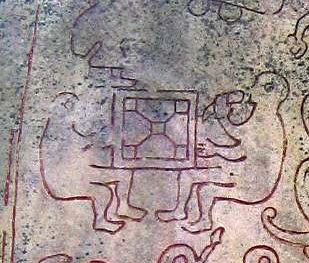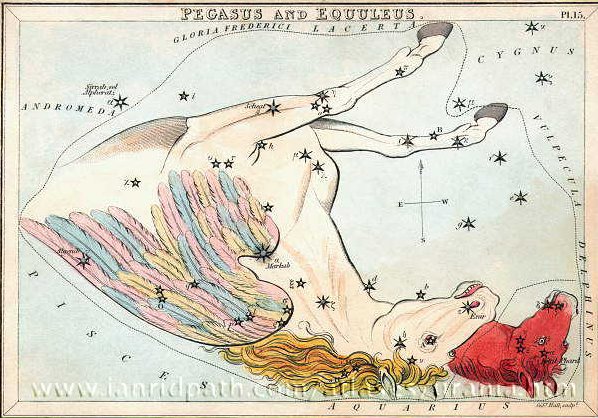Ba7.4
Anyhow, the difficult (feverish) month of February corresponded south of the equator
to the month of August.
... At the beginning of 44 B.C. - when Ceasar
was still alive - the Senate decided to raise statues of him in
all the temples and to sacrifice to him on his birthday in the
month Quintilis, which in honour of him was renamed July.
He was raised to the status of a god (among the other gods of
the state) under the name Jupiter Julius. Marcus Antonius, who
this year was consul together with Caesar, became high priest
and responsible for the ceremonies. In the middle of February,
at the time of the old feast of Lupercalia [Lupus
= Wolf], he ran around naked and whipped the Roman ladies with
thongs made from goat-skin [februa], in order to promote
their fertility ...
In the month of 'the red opening' (vaha mea) the dawn
(birth, hanau) of a new year child was 'ahead' (up in front):
 |
 |
 |
 |
 |
|
Ba6-40 |
Ba6-41 (248) |
Ba6-42 |
Ba6-43 (250) |
Ba6-44 |
|
kua hanau ïa |
ki te hupe o ruga |
kua tuu huki ïa ki te toga |
e tagata mau - i te
vaha mea |
e tagata hoko |
|
Hupee.
Mucus; hupeehupee, asthma. T Pau., Ta.:
hupe, mucus. Churchill. Ta.: Hupe,
mucus. (Sa.: isupē,
id.) Ma.: hupe,
id. Churchill. Rhume, air froide.
Jaussen according to Barthel.
Ruga. Upper part, higher part; when used
as a locative adverb, it is preceded by a
preposition: i ruga, above, on; ki ruga,
upwards, mai ruga, from above. When used
with a noun the same preposition is repeated:
he-ea te vî'e Vakai, he-iri ki ruga ki te Ahu ruga,
the woman Vakai went, she climbed Ahu Runga.
Ruga nui, high, elevated, lofty: kona ruga
nui, high place, elevated position, high office;
mana'u ruga nui, elevated thoughts. Vanaga.
High up; a ruga, above; ki ruga, on,
above, upon; ma ruga, above; o ruga,
upper; kahu o ruga, royal (sail); ruga iho,
celestial. Hakaruga, to accumulate, to draw
up. P Pau., Mgv.: ruga, above. Mq.: úna,
úka, id. Ta.: nua, nia, id.
Churchill.
Hoko. 1. To jump; to
rock or swing in rhythm with the chants in
festivals, as was the ancient custom; an ancient
dance. He to'o mai e te hoa manu i te mamari ki toona rima, he ma'u,
he hoko, the 'bird master' receives the egg in
his hand and carries it, dancing. 2. Number prefix:
'in a group of...': hokotahi,
alone; hokorua, in a group of two (also companion, e
hakarere te kai mo toou hokorua, leave some food
for my companion); hakatoru, in a group of
three, etc.; hokohía, in a group of how many?
Hokohía ana oho koe ki te rano? With how many
people will you go to the volcano? Vanaga. 1. To
traffic, to trade, to buy, to ransom (hoò);
hoòa te kaiga, to buy land. 2. To sport, to
play. Churchill. Move the body to and fro with the
rythm of a song. Barthel. |
|
Febr 5 (36) |
6 |
7 (403) |
8 |
9 (40) |
|
... On February 9
the Chorti Ah K'in, 'diviners', begin the
agricultural year. Both the 260-day cycle and the
solar year are used in setting dates for religious
and agricultural ceremonies, especially when those
rituals fall at the same time in both calendars. The
ceremony begins when the diviners go to a sacred
spring where they choose five stones with the proper
shape and color. These stones will mark the five
positions of the sacred cosmogram created by the
ritual. When the stones are brought back to the
ceremonial house, two diviners start the ritual by
placing the stones on a table in a careful pattern
that reproduces the schematic of the universe. At
the same time, helpers under the table replace last
year's diagram with the new one. They believe that
by placing the cosmic diagram under the base of God
at the center of the world they demonstrate that God
dominates the universe. The priests place the stones
in a very particular order. First the stone that
corresponds to the sun in the eastern, sunrise
position of summer solstice is set down; then the
stone corresponding to the western, sunset position
of the same solstice. This is followed by stones
representing the western, sunset position of the
winter solstice, then its eastern, sunrise position.
Together these four stones form a square. They sit
at the four corners of the square just as we saw in
the Creation story from the Classic period and in
the Popol Vuh. Finally, the center stone is placed
to form the ancient five-point sign modern
researchers called the quincunx ...
 |
|
α Oct. (321.5), δ
Equulei (321.7),
φ
Capricorni (321.8) |
KITALPHA (Part of a Horse) =
α
Equulei
(322.0),
ALDERAMIN (The Right Arm) =
α
Cephei
(322.9) |
DAI =
ι
Capricorni
(323.5),
β
Equulei (323.8) |
γ
Pavonis (324.1),
YAN =
ζ
Capricorni
(324.6) |
Al Sa'd al Su'ud-22 (Luckiest of the Lucky) /
Emptiness-11 (Rat)
TSIN = 36 Capricorni
(325.2),
ALPHIRK (The Flock) =
β
Cephei
(325.7),
SADALSUD =
β
Aquarii,
ξ
Gruis (325.9) |
 |
|
κ Pyxidis (138.0), ε Pyxidis (138.5) |
π
Cancri (139.2),
MIAPLACIDUS =
β
Carinae
(139.3),
TUREIS (Little Shield) =
ι
Carinae
(139.8) |
No star listed (140) |
θ
Pyxidis (141.5),
MARKAB VELORUM =
κ
Velorum
(141.5),
AL MINHAR AL ASAD (The Nose of the Lion) =
κ
Leonis
(141.6),
λ
Pyxidis (141.9) |
Star-25 (Horse) /
ANA-HEU-HEU-PO-5 (Pillar where debates were held)
ALPHARD (The Horse) =
α
Hydrae
(142.3),
ω
Leonis (142.6),
τ¹
Hydrae (142.7) |
|
Aug 6 |
7 |
8 |
9 |
10 (222) |
|
 |
 |
 |
 |
 |
|
Ba7-1 |
Ba7-2 |
Ba7-3
(250 + 4) |
Ba7-4 |
Ba7-5 |
|
ki te kea e |
kua rere te manu
ki ruga |
o te tagata -
koia kua vaha mea |
ko te tao kua mau - i te ika |
eko te tao - kua
here ki te ika |
|
Febr 10 |
11 |
12 (408) |
13 |
14 |
| Aug 11 |
12 |
13 (225) |
14 |
15 |
From reading the G text - cfr
Gb6-26 - we
have learned that Sirrah,
i.e. α
Andromedae, the Navel of the Horse, the Topknot of Taraga,
... 'From
the time I was in your womb,' Maui went on, 'I have
known the names of these children of yours. Listen,' he said
as he pointed to his brothers in turn. 'You are Maui mua,
you are Maui roto, you are Maui taha, and you
are Maui pae. And as for me, I am Maui potiki,
Maui-the-last-born. And here I am.' When he had
finished, Taranga had to wipe her eyes because there
were tears in them, and she said: 'You are indeed my
lastborn son. You are the child of my old age. When I had
you, no one knew, and what you have been saying is the
truth. Well, as you were formed out of my topknot you can be
Maui tikitiki a Taranga.' So that became his name,
meaning Maui-formed-in-the-topknot-of-Taranga.
And this is very strange, because women in those days did
not have topknots. The topknot was the most sacred part of a
person, and only men had them ...
was positioned at 0h,
which marked
March 21 (80) and the northern spring equinox according to
the Gregorian calendar.

The glyph number of Gb6-26 was 408, presumably a reference to February
12 (408 = 365 + 43 = 225 + 183). The topknot was the very
last part of the old year with
Algenib Pegasi at the
very first day of the new year.
|
 |
43
|
 |
|
Ba6-3 (210) |
Ba7-3
(254) |
|
Dec 30 (364 =
181 + 183) |
Febr 12 (408
= 225 + 183) |
|
Φ Sagittarii
(*284) |
Nashira
(*328) |
|
Sirius (*101) |
Ukdah (*145) |
|
June 30 (181) |
Aug 13 (225) |
For according to the Mayas August 13 was the
established date for the creation of
our present world.

|










